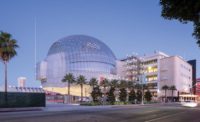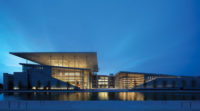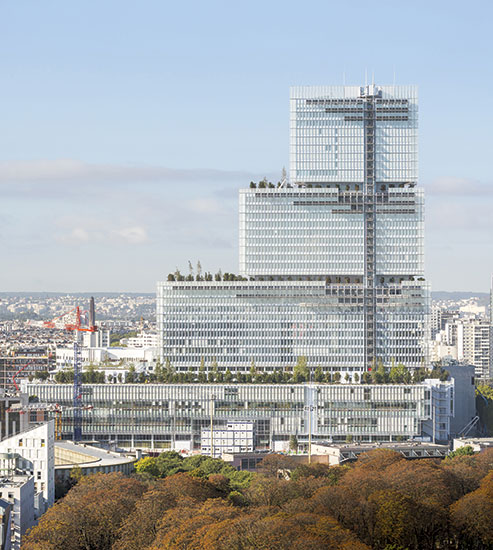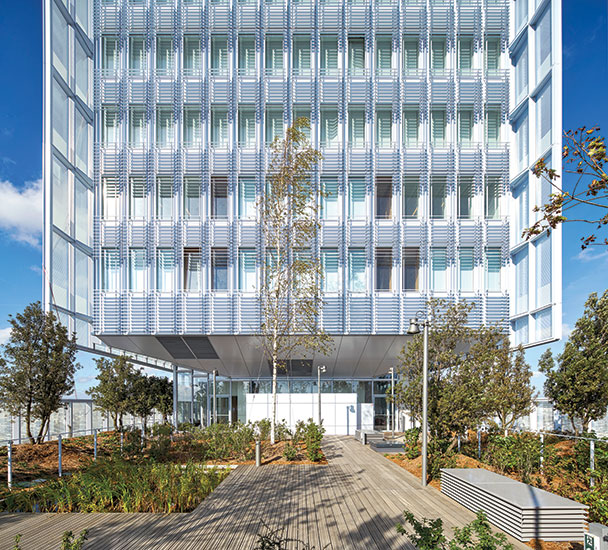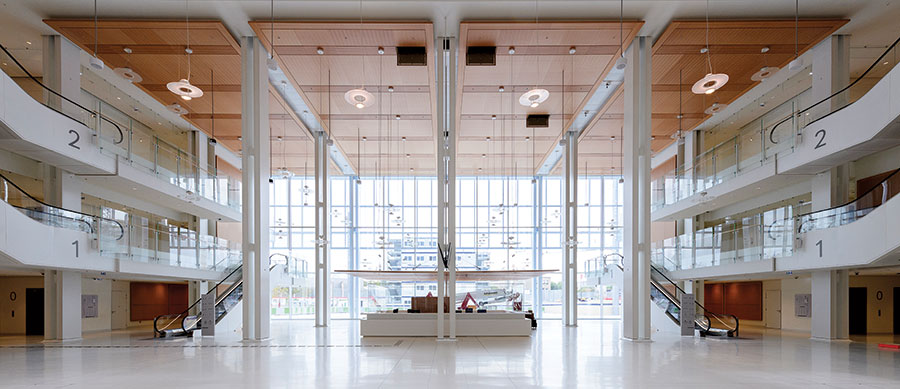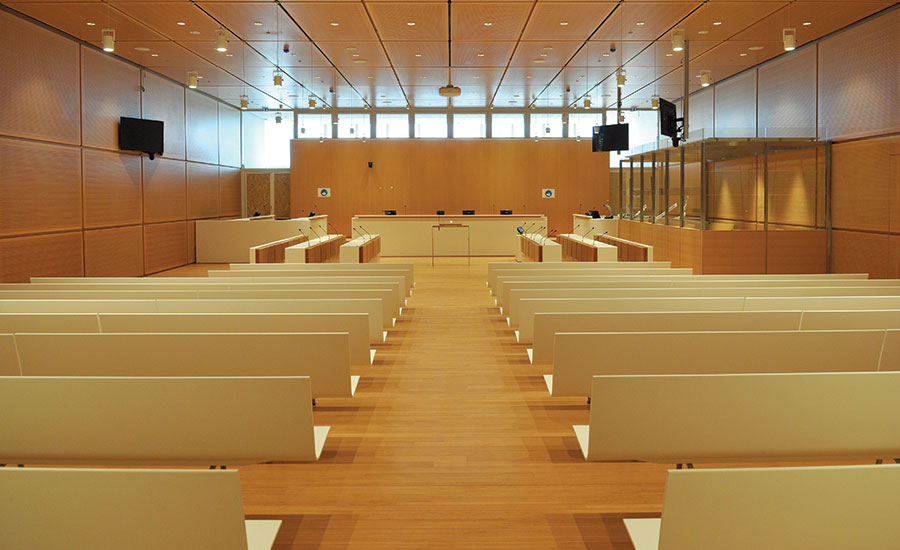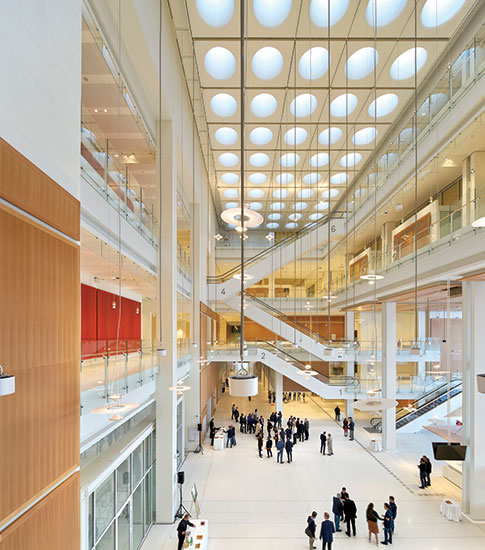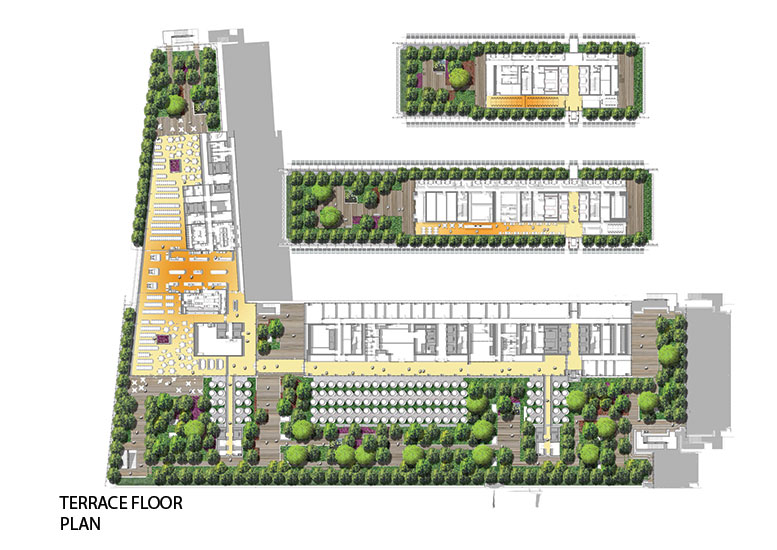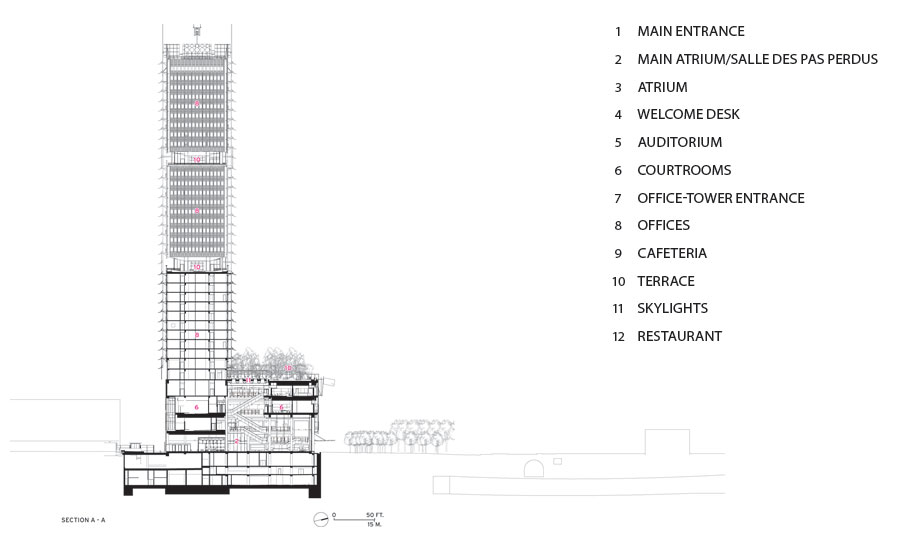Tribunal de Paris by Renzo Piano Building Workshop
Paris

Animating the facade are rows of photovoltaics—just one of the numerous sustainable strategies in the building.
Photo © RPBW. PH. Sergio Grazia

Photo © Ph. Guignard / Air-Images.net
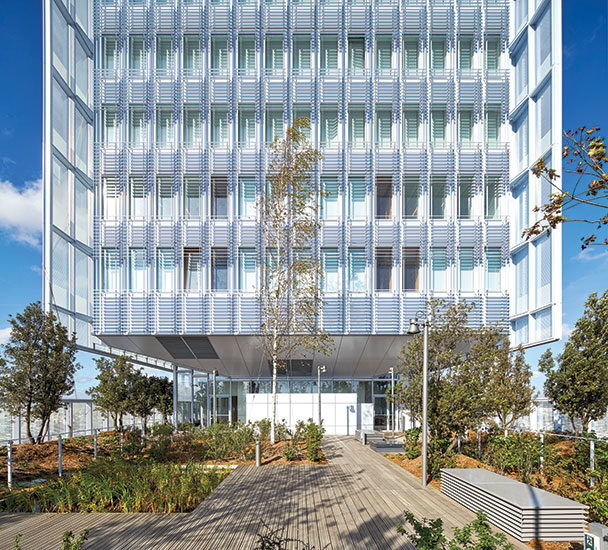
The building includes three roof terraces, planted with 500 trees, for use by those who work in the courts. The glazing on the top three volumes of the tower extends beyond the facade.
Photo © Michel Denancé

Natural light spills into the Salle des Pas Perdus through circular skylights, while a smaller atrium and a courtroom also are open to daylight.
Photo © Laurent Zylberman

Natural light spills into the Salle des Pas Perdus through circular skylights, while a smaller atrium and a courtroom also are open to daylight.
Photo © RPBW. PH. Francesca Avanzinelli

Natural light spills into the Salle des Pas Perdus through circular skylights, while a smaller atrium and a courtroom also are open to daylight.
Photo © Michel Denancé

Image courtesy Renzo Piano Building Workshop

Image courtesy Renzo Piano Building Workshop

Image courtesy Renzo Piano Building Workshop

Image courtesy Renzo Piano Building Workshop










Architects & Firms
When you think of Paris, you don’t think of skyscrapers. If you ride the escalator to the top of Centre Georges Pompidou, the city spreads out around you, a charming jumble of roofs on buildings mostly five or six stories high, as prescribed by Baron Haussmann in the 19th century. Except for the Eiffel Tower, Parisians have hated protrusions in their skyline.
But that is changing. Height limits set in 1977—after the despised 689-foot Tour Montparnasse was built—were loosened in 2010, to allow for higher-density housing in parts of the city. And now, visible from atop the Pompidou, is the slender profile of a new glass tower far in the distance to the north.
Additional Content:
Jump to credits & specifications
The Tribunal de Paris by Renzo Piano Building Workshop (RPBW) is, at 525 feet, the third-highest structure in Paris (not counting the towers of La Défense, which are just outside the western city limits). The largest courthouse in Europe, with 90 courtrooms, it is significant not only for its scale, but for the hopes pinned on it as an urban catalyst. Perched just inside the Boulevard Périphérique—the heavily trafficked highway that encircles the city—the building, opening in April, is meant to breathe new life into an area that includes rail tracks and industrial brownfields near the Porte de Clichy, as well as the notoriously tough banlieue, or suburb, beyond the ring road, Saint-Denis. “It is the most important topic today, the work on the edge of cities to transform the peripheries,” says Renzo Piano. Indeed, the neighborhood has already been changing, with a fairly new park called Martin Luther King serving existing residential blocks farther to the south and more apartment buildings and offices that are springing up; soon a new tramway station and subway stop will open.
While Piano’s beautifully detailed courthouse may not look like radical architecture, it is an exceptionally strategic and sensitive response to a brief that required a building to accommodate 8,500 people a day—judges, lawyers, administrators, plaintiffs and defendants, and the public. How could such an immense facility be built without overwhelming a neighborhood in transition?
The answer is lightness: luminosity and dematerialization seem to have guided every aspect of the design. At the base of the 1.5 million-square-foot concrete structure is an 88-foot-high podium, L-shaped in plan. Atop its long side are stacked three slender boxes of diminishing size as they rise: the east and west elevations appear stepped; from the south and north, the tower looks very slim. Each box is cantilevered over the one below—they appear to float—and their stepped formation leaves space for three rooftop gardens on the volumes beneath. The building has a double skin—the inner one is glass and metal panels, while the dazzling outer facade is all glass (a shading system in between is deployed automatically against the sun). On the upper volumes, fine blades of glazing extend beyond the facade, adding to the effect of transparency.
A plaza designed by the Paris firm Moreau Kusunoki leads into a low-ceilinged entrance vestibule for security. Beyond that, the space opens up into a vast atrium that soars to the top of the podium, with sunshine spilling in from light scoops on the roof. Ringed by the floors containing the courtrooms, the big, bright hall is known as the Salle des Pas Perdus—the Room of Lost Steps—where people can get information, talk to lawyers, or pace while awaiting verdicts. “What I hoped it would be is a Palais de Lumière,” says Piano, “a palace of light that celebrates clarity and luminosity, to try to make a place that is not intimidating, that is not creating fear but confidence.”
The material palette inside is a simple trifecta of white finishes, beechwood, and daylight. (“It’s a really stupid idea to make a building like this too chic,” says Piano.) The podium holds all 90 courtrooms, which vary from quite small for family court to those that can hold up to 250 people. In most, natural light enters through clerestories, and wood furnishings contrast with elegantly minimal white custom benches, designed by RPBW.
The three-stepped tower above holds offices for 2,500 judges, magistrates, prosecutors, and clerks, many of whom have worked their entire careers in the historic Palais du Justice on the Île de la Cité, in the heart of Paris. Conscious of the culture shock they may feel in moving to the city’s edge, the architects have designed a number of amenities just for staff. Chief among them are the three rooftop terraces planted with 500 trees. A 730-seat employee restaurant on the eighth floor, its walls a vivid yelloworange, opens to the largest garden, of 75,000 square feet, with stunning views of the city. Elsewhere are two double-height winter gardens and small balconies onto which to retreat to light up a Gauloise. An exterior shaft for a glass elevator vertically punctuates the eastern elevation and also will give passengers amazing vistas of Paris.
This courthouse—which recently won France’s highest architectural honor, the Prix de l’Équerre d’Argent, or Silver Square—is not a monument, insists Piano.
Like Centre Pompidou, which he designed with Richard Rogers when they were both young and little known, more than 40 years ago, here is another public building in Paris that is anti-monumental. “Dignity is important for a civic building,” says Piano, “but monumentality is always wrong.” The Tribunal is not an edifice of stone and colonnades—nor should it be. In a neighborhood that is, in every sense, on the edge, it projects a presence that is both powerful and luminous.
CreditsArchitect: Renzo Piano Building Workshop — Bernard Plattner, partner in charge
Personnel in architect's firm who should receive special credit: S.Giorgio-Marrano, J.B.Mothes, D.Rat, G.Chung, S.Cloarec, B.Granet, A.Greig, C.Guézet, A.Karcher, M.Sismondini, N.Aureau, G.Avventi, A.Belvedere, A.Bercier, F.Bolle, L.Bot, A.Boucsein, N.Byrelid, J.Chevreux, S.Crabot, J.Franco, N.Grawitz, B.Guimaraes, V.Houeiss, N.Maes, J.Sobreiro, S.Stevens, M.van der Staay, T.Heltzel, M.Matthews, O.Aubert, C.Colson, Y.Kyrkos, Y.Chaplain, L.Le Roy, J.Moolhuijzen, P.Pires da Fonte, B.Schelstraete, F.Garrigues-Cortina, B.Akkerhuis, M.Angelozzi
Consulting Architect:
Sustainability: ELAN, Eléments Ingénieries (competition, 2010-2011)
Facades: RFR
Vertical Transportation: Movveo
Acoustics: LAMOUREUX acoustics
Signage: M.Harlé/J.Cottencin
Lighting: Cosil Peutz Lighting Design
Planting: C.Guinaudeau, AIA Ingénierie
Specification Consultant: Ecotec
Plaza: Moreau Kusunoki
Engineers SETEC Bâtiment, Berim (m/e/p); SETEC TPI (structural)
General contractor: Bouygues Bâtiment
Client: Etablissement Public du Palais de Justice de Paris + Bouygues Bâtiment |
SpecificationsWindows Schüco
Glass Glazing Saint-Gobain, Guardian
Doors and Security Devices Geze Dorma
Furniture Artemide, Vitra, Knoll, Cassina, Silvera, Majencia, Sokoa, Pedrali-Negostock, Tecno, Krion
Lighting Guzzini, Artemide, Targetti, Bega
Escalators / Elevators Kone
Photovoltaic System ISSOL |


